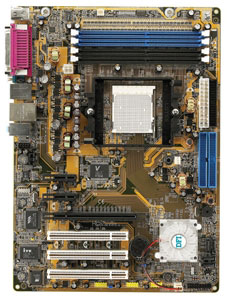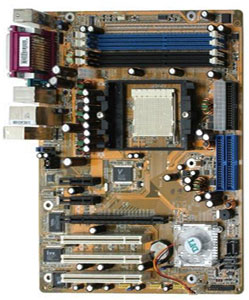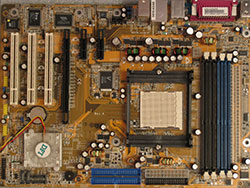Investigations into Socket 939 Athlon 64 Overclocking
by Jarred Walton on October 3, 2005 4:35 PM EST- Posted in
- CPUs
DFI nF4 Infinity
We wanted to spend a few minutes looking at the motherboard options before continuing - a mini review if you will, as we haven't officially reviewed this board and we want to compare it to the LANPARTY UT nF4 Ultra-D. We're using the DFI NF4 INFINITY, but it is actually just the new name for the DFI NF4-DAGF. There are multiple models of the INFINITY/DAGF, using everything from the base nForce4 4X chipset to the top nForce4 Ultra and SLI. We're using the "middle" model, the nForce4 Standard. The main difference is that all the networking features of the chipset are enabled and official support for 1000 MHz HyperTransport is also present. The only extra that the Ultra offers is SATA-II (3 Gbps) hard drive support, while the 4X limits the HT bus to 800 MHz. SLI adds dual PEG slots to the mix, of course. We heard directly from DFI that the DAGF was being renamed to "INFINITY", but if you still think that there's a difference, we offer these two shots obtained from Newegg and TigerDirect.
TigerDirect lists the board as the INFINITY while Newegg uses the older DAGF moniker. We've resized the images for comparison, with TigerDirect on the left and Newegg on the right. Other than a slight difference in contrast levels and viewing angle, we can't spot any changes. Besides, we're inclined to take DFI at their word. Here's a better shot of our particular board.
The layout is generally good, if not great. The 4-pin ATX12V connector is about the only minor concern, as it's between the RAM and CPU socket. The cable will need to be snaked over the CPU heat sink, but it shouldn't present any real problems. IDE, floppy, SATA, and 24-pin ATX power are all located in the preferred board edge locations. The location of the extra Firewire port is a bit odd, so if you plan to use that for a front case port, you'll need to do some creative routing of the cable. The RAM slots are configured such that channel A is slots 1 and 3 while channel B is slots 2 and 4. What that means is that with two DIMMs installed in dual channel operation, there is very little room between the DIMMs. We prefer channel A to be slots 1 and 2 with B being 3 and 4, as the majority of people will run only two DIMMs, and a bit of extra breathing room isn't a bad idea. Everything else looks fine, with enough clearance around the CPU socket for most HSFs, and room between the PEG slot and the NB HSF.
Unlike the LanParty series, the Infinity is pretty boring in terms of looks. A standard brownish PCB with no UV reactive parts isn't the best fit for a windowed case, but if you're like me and don't care for case windows, it doesn't really matter. Also missing relative to the LanParty are the rounded cables and onboard power and reset buttons. Those buttons can be handy for testing outside of a case. (Of course, if you're adventurous, you can always just use a small metal item to short the required pins to accomplish the same result - don't blame us if you fry your system that way, though!) One complaint that we did have was with the X16 PEG retention mechanism. Many boards have a clip that locks the rear of the graphics card into place, but the Infinity has a sort of "hook" design. It works okay for holding the GPU in the slot, but removing the GPU can be a bit more difficult than what we'd like. We'd also prefer a larger heat sink on the Northbridge, perhaps with passive cooling. The NB did get quite warm at the highest overclocks, and there looks to be plenty of room to move it up closer to the CPU socket. The small fan did make a bit of noise, though "silent" and "overclocking" rarely go together.
The feature list of the board is very similar to the LanParty boards. The BIOS offers very good tweaking options, but voltages are slightly more limited than the higher-end boards. 3.2V maximum on the RAM is plenty for most people, but it did prove limiting on some OCZ VX Gold that we tried, reaching a maximum of 2-3-3-8-1T timings at DDR500. (That RAM was not used during testing for this particular article, so we mention it merely as a point of interest.) The CPU voltage topped out a 1.85V, which is a lot higher than the default voltage of most 90nm AMD chips. We're a little uncomfortable pushing our CPUs even to that level, though with water cooling or something more exotic, a higher voltage level might prove useful.
Overall, we're very impressed with this value offering from DFI. They basically stripped away the flash and the frills and knocked around $20 off the price of the LanParty UT nF4 Ultra-D. The question is: do you really want to save the $20? Modders can try turning the Ultra-D board into an SLI model, and the rounded cables and UT reactive design may appeal to some. On the other hand, the Infinity SLI guarantees SLI capability and costs about the same amount as the Ultra-D. If you want to push overclocking a little further, the LanParty boards (and competitors) might be a bit better. If you're trying to stick to a budget without cutting necessary features, the Infinity line keeps you covered.
Having selected the processor and motherboard, we're still only half way through our critical component choices. Hard drives, floppy drives, optical drives, and even graphics cards have little to no impact on overclocking, so you can get whatever you want in those areas. We'd question the purchase of a low end graphics card with such a system, unless there's a specific desire to have a fast processor for video/audio encoding. That sort of work is often for a real job, though, and we're hesitant to suggest that anyone overclock a system that is being used for important work. If a gaming PC crashes and somehow corrupts your entire hard drive, you reformat and reinstall. A work PC going through the same problems would be a lot more painful. We've already given our warnings about overclocking, however, so do what you will. What remains, then, are the last three components that will generally have an impact on your overclocking endeavors.
We wanted to spend a few minutes looking at the motherboard options before continuing - a mini review if you will, as we haven't officially reviewed this board and we want to compare it to the LANPARTY UT nF4 Ultra-D. We're using the DFI NF4 INFINITY, but it is actually just the new name for the DFI NF4-DAGF. There are multiple models of the INFINITY/DAGF, using everything from the base nForce4 4X chipset to the top nForce4 Ultra and SLI. We're using the "middle" model, the nForce4 Standard. The main difference is that all the networking features of the chipset are enabled and official support for 1000 MHz HyperTransport is also present. The only extra that the Ultra offers is SATA-II (3 Gbps) hard drive support, while the 4X limits the HT bus to 800 MHz. SLI adds dual PEG slots to the mix, of course. We heard directly from DFI that the DAGF was being renamed to "INFINITY", but if you still think that there's a difference, we offer these two shots obtained from Newegg and TigerDirect.
 |
 |
TigerDirect lists the board as the INFINITY while Newegg uses the older DAGF moniker. We've resized the images for comparison, with TigerDirect on the left and Newegg on the right. Other than a slight difference in contrast levels and viewing angle, we can't spot any changes. Besides, we're inclined to take DFI at their word. Here's a better shot of our particular board.
The layout is generally good, if not great. The 4-pin ATX12V connector is about the only minor concern, as it's between the RAM and CPU socket. The cable will need to be snaked over the CPU heat sink, but it shouldn't present any real problems. IDE, floppy, SATA, and 24-pin ATX power are all located in the preferred board edge locations. The location of the extra Firewire port is a bit odd, so if you plan to use that for a front case port, you'll need to do some creative routing of the cable. The RAM slots are configured such that channel A is slots 1 and 3 while channel B is slots 2 and 4. What that means is that with two DIMMs installed in dual channel operation, there is very little room between the DIMMs. We prefer channel A to be slots 1 and 2 with B being 3 and 4, as the majority of people will run only two DIMMs, and a bit of extra breathing room isn't a bad idea. Everything else looks fine, with enough clearance around the CPU socket for most HSFs, and room between the PEG slot and the NB HSF.
Unlike the LanParty series, the Infinity is pretty boring in terms of looks. A standard brownish PCB with no UV reactive parts isn't the best fit for a windowed case, but if you're like me and don't care for case windows, it doesn't really matter. Also missing relative to the LanParty are the rounded cables and onboard power and reset buttons. Those buttons can be handy for testing outside of a case. (Of course, if you're adventurous, you can always just use a small metal item to short the required pins to accomplish the same result - don't blame us if you fry your system that way, though!) One complaint that we did have was with the X16 PEG retention mechanism. Many boards have a clip that locks the rear of the graphics card into place, but the Infinity has a sort of "hook" design. It works okay for holding the GPU in the slot, but removing the GPU can be a bit more difficult than what we'd like. We'd also prefer a larger heat sink on the Northbridge, perhaps with passive cooling. The NB did get quite warm at the highest overclocks, and there looks to be plenty of room to move it up closer to the CPU socket. The small fan did make a bit of noise, though "silent" and "overclocking" rarely go together.
| DFI nF4 Infinity Specifications | |
| CPU Interface | Socket 939 Athlon 64 |
| Chipset | nForce4 Standard (single chip) |
| BUS Speeds | 200MHz to 450MHz (in 1MHz increments) |
| PCI/AGP Speeds | Asynchronous (Fixed) |
| PCI Express | 100MHz to 145MHz in 1MHz increments |
| CPU Voltage | Auto, 0.800V to 1.850V in 0.025V increments |
| DRAM Voltage | 2.5V to 3.2V in 0.1V increments |
| Chipset Voltage | 1.5V, 1.6V, 1.7V |
| Hyper Transport Ratios | Auto, 1.0, 2.0, 3.0, 4.0, 5.0 |
| LDT Bus Transfer | 16/16, 16/8, 8/16, 8/8 |
| CPU Ratios | Auto, 4x to 25x in .5x increments |
| DRAM Speeds | Auto, 100, 133, 150, 166, 200 |
| Memory Command Rate | Auto, 1T, 2T |
| Memory Slots | Four 184-pin DDR Dual-Channel Slots Unbuffered ECC or non-ECC Memory to 4GB Total |
| Expansion Slots | 1 X16 PCIe Slots 2 X1 PCIe 3 PCI Slots |
| Onboard SATA | 4-Drive SATA by nF4 |
| Onboard IDE | Two Standard NVIDIA ATA133/100/66 (4 drives) |
| SATA/IDE RAID | 4-Drive SATA plus 4-Drive IDE (8 total) Can be combined in RAID 0, 1 |
| Onboard USB 2.0/IEEE-1394 | 10 USB 2.0 ports supported nF4 2 1394A FireWire ports by VIA VT6307 |
| Onboard LAN | Gigabit Ethernet PCIe by Vitesse VSC8201 PHY |
| Onboard Audio | Realtek ALC655 6-Channel codec 3 UAJ audio jacks CD-in, front audio, and coaxial SPDIF In and Out |
| BIOS | Award 8/11/2005 Release, CK84D811 |
The feature list of the board is very similar to the LanParty boards. The BIOS offers very good tweaking options, but voltages are slightly more limited than the higher-end boards. 3.2V maximum on the RAM is plenty for most people, but it did prove limiting on some OCZ VX Gold that we tried, reaching a maximum of 2-3-3-8-1T timings at DDR500. (That RAM was not used during testing for this particular article, so we mention it merely as a point of interest.) The CPU voltage topped out a 1.85V, which is a lot higher than the default voltage of most 90nm AMD chips. We're a little uncomfortable pushing our CPUs even to that level, though with water cooling or something more exotic, a higher voltage level might prove useful.
Overall, we're very impressed with this value offering from DFI. They basically stripped away the flash and the frills and knocked around $20 off the price of the LanParty UT nF4 Ultra-D. The question is: do you really want to save the $20? Modders can try turning the Ultra-D board into an SLI model, and the rounded cables and UT reactive design may appeal to some. On the other hand, the Infinity SLI guarantees SLI capability and costs about the same amount as the Ultra-D. If you want to push overclocking a little further, the LanParty boards (and competitors) might be a bit better. If you're trying to stick to a budget without cutting necessary features, the Infinity line keeps you covered.
Having selected the processor and motherboard, we're still only half way through our critical component choices. Hard drives, floppy drives, optical drives, and even graphics cards have little to no impact on overclocking, so you can get whatever you want in those areas. We'd question the purchase of a low end graphics card with such a system, unless there's a specific desire to have a fast processor for video/audio encoding. That sort of work is often for a real job, though, and we're hesitant to suggest that anyone overclock a system that is being used for important work. If a gaming PC crashes and somehow corrupts your entire hard drive, you reformat and reinstall. A work PC going through the same problems would be a lot more painful. We've already given our warnings about overclocking, however, so do what you will. What remains, then, are the last three components that will generally have an impact on your overclocking endeavors.











101 Comments
View All Comments
DonTrowbridg3 - Thursday, October 4, 2018 - link
2018 checking in. Thanks for all the info and comments. Very helpful in overclocking my FX-60, A8N32-SLI, dual 8800 GTX